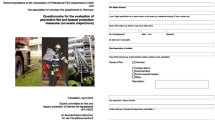Abstract
For a successful fire suppression, it is essential to detect and intervene forest fires as early as possible. Fire lookout towers are crucial assets in detecting forest fires, in addition to other technological advancements. In this study, we performed a visibility analysis on a network of fire lookout towers currently operating in a relatively fire-prone region in Turkey’s Western Black Sea region. Some of these towers had not been functioning properly; it was proposed that these be taken out of the grid and replaced with new ones. The percentage of visible areas under the current network of fire lookout towers was 73%; it could rise to 81% with the addition of newly proposed towers. This study was the first research to conduct a visibility analysis of current and newly proposed fire lookout towers in the Western Black Sea region and focus on its forest fire problem.










Similar content being viewed by others
References
Akay, A.E., Sivrikaya, F., Yenilmez, N., & Taylan, H. (2012). Yangin gozetleme kulelerinin lokasyonlarinin CBS ortaminda gorunurluk analizi ile degerlendirilmesi, KSU Muhendislik Bilimleri Dergisi, 226–231. (In Turkish).
Akbulak, C., & Özdemir, M. (2008). The application of the visibility analiysis for fire observation towers in The Gelibolu Peninsula (NW Turkey) using GIS. Balwois. Proceedings of the Conference on Water Observation and Information System For Decision Support, 2008-Ohrid, Republic of Macedonia-27, 31 May 2008.
Aricak, B., Kucuk, O., & Enez, K. (2014a). Determination of pumper truck intervention ratios in zones with high fire potential by using geographical information system. Journal of Applied Remote Sensing, 8(1). doi:10.1117/1.JRS.8.083598.
Aricak, B., Kucuk, O., & Enez, K. (2014b). Determining a fire potential map based on stand age, stand closure and tree species, using satellite imagery (Kastamonu Central Forest Directorate sample). Croation Journal of Forest Engineering, 35(1), 101–108.
Artsybashev, E. S. (1984). Detection of forest fires. In ‘Forest fires and their control’, Russian Translations Series 15 (pp. 46–61). Rotterdam: AA Balkema.
Askin, Y. (2004). Visibility analyses for observation fıre towers in Kemalpasa mountaiın and determining alternative observation points. 3rd. GIS days in Turkey.
Berni, J. F., Galán, R. C., & González, L. C. (2008). A vision-based monitoring system for very early automatic detection of forest fires. WIT Transactions on Ecology and the Environment. Modelling, Monitoring and Management of Forest Fires I, 119, 161–170. doi:10.2495/FIVA080171.
Bilgili, E., & Kucuk, O. (2002). Orman yanginlarinin uzaktan algilama teknigi ile belirlenmesi, IV (pp. 1631–1637). Sanliurfa: GAP Muhendislik Kongresi In Turkish.
Brown, A. A., & Davis, K. P. (1973). Forest fire detection. In W. P. Orr, N. Frankel, & S. Langman (Eds.), Forest fire—control and use (2nd ed., pp. 327–344). McGraw-Hill: New York.
Buck, C. C. (1938). Factors influencing the discovery of forest fires by lookout observers. Journal of Agricultural Research, 56(4), 259–268.
Budd, G. M., Brotherhood, J. R., Hendrie, A. L., Jeffery, S. E., Beasly, F. A., Costin, B. P., Zhien, W., Baker, M. M., Cheney, N. P., & Dawson, M. P. (1997). Stress, stain, and productivity in men suppressing wildland fires with hand tools. International Journal of Wildland Fire, 7(2), 69–76. doi:10.1071/WF9970069.
Byram, G.M., & Jemison, G.M. (1948). Some principles of visibility and their application to forest fire detection. U.S. Department of Agriculture, Technical Bulletin No, 954.
Catry, F.X., Rego, F.C., Santos, T., Almeida, J., & Relvas, P. (2007). Forest fires prevention in Portugal—using GIS to help improving early fire detection effectiveness. International Forest Fire Conference, Wildfire 2007, Sevilla, Spain.
Chandler, C., Cheney, P., Thomas, P., Trabaud, L., & Williams, D. (1983). Detection. In: Fire in forestry—volume II: forest fire management and organization. pp. 69–73. Wiley. New York.
Cruz, H., Eckert, M., Meneses, J., & Martinez, J. F. (2016). Efficient forest fire detection index for application in unmanned aerial systems (UASs). Sensors, 16(6), 893. doi:10.3390/s16060893.
Cumming, S. G. (2005). Effective fire suppression in boreal forests. Canadian Journal of Forest Research, 35(4), 772–786. doi:10.1139/x04-174.
Davis, K. P. (1959). Detection. In ‘Forest fire. Control and use’. (Ed. KP Davis) (pp. 282–303). McGraw-Hill: NewYork
Fan, W., Meng, X., Liu, X., & Hu, N. (2010). The design and realization on effectively fire tower planning based on MapGIS-TDE. Journal of Geographic Information Systems, 2, 49–53.
Fernandez-B, J., Carmona-G, R., Martinez-C, J. F., & Vazquez, A. R. (2012). Early forest fire detection by vision enabled wireless sensor networks. International Journal of Wildland Fire, 938–949. doi:10.1071/WF11168.
Garcia, M. P., Moreno, R. S., Téllez, E. R., et al. (2010). Viewshed analysis for improving the effectiveness of watchtowers in the north of Mexico. The Open Forest Science Journal, 3, 17–22.
GDF. (1995). 285 Sayili teblig, Orman yanginlarinin onlenmesi ve sondurulmesi uygulama esaslari (p. 138s). Ankara: Orman Genel Mudurlugu Yayini (In Turkish).
GDF. (2014). Orman yanginlari ile mucadele faaliyet raporu. Ankara: Orman Genel Mudurlugu yayinlari (In Turkish).
GDM (2015). http://tr.climate-data.org/location/19451/, accessed 17 January 2016.
Guettouche, M. S., Derias, A., Boutiba, M., Bounif, M. A., Guendouz, M., & Amar Boudella, A. (2011). A fire risk modelling and spatialization by GIS. Journal of Geographical Information System, 3, 247–258.
Hirsch, K. G., & Martell, D. L. (1996). A review of initial attack fire crew productivity and effectiveness. International Journal of Wildland Fire, 6(4), 199–215. doi:10.1071/WF9960199.
Holmes, T. P., & Calkin, D. E. (2013). Econometric analysis of fire suppression production functions for large wildland fires. International Journal of Wildland Fire, 22, 246–255. doi:10.1071/WF11098.
Kucuk, O., & Bilgili, E. (2006). The conveyance of fire behavior characteristics into practice by using Geographical Information Sysyems (GIS): A case study in Kastamonu. Kastamonu Universitesi Orman Fakultesi Dergisi, 6(2), 262–273.
Kucuk, O., Bilgili, E., & Fernandes, P.M. (2015). Fuel modeling and potential fire behavior in Turkey. Sumarski list, (11–12), 553–560.
Kucuk, O., Kalaycik, H. H., & Kapukiran, I. (2008a). Bati Karadeniz ormanlarinda orman yangini gercegi. IV. Duzce: Ulusal Orman Fakulteleri Ogrenci Kongresi (In Turkish).
Kucuk, O., Bilgili, E., & Saglam, B. (2008b). Estimating crown fuel loading for calabrian pine and Anatolian black pine. International Journal of Wildland Fire, 17, 147–154. doi:10.1071/WF06092.
Maloy, M. A., & Dean, D. J. (2001). An accuracy assessment of various gıs-based viewshed delineation techniques. Photogrammetric Engineering & Remote Sensing, 67(11), 1293–1298.
Matthews, S., Sullivan, A., Gould, J., Hurley, R., Ellis, P., & John Larmour, J. (2010). Evaluation of three fire detection systems. Bushfire Cooperative Research Centre Report Number: CSE-BDA-002.
Mees, R. M. (1976). Computer evaluation of existing and proposed fire lookouts. USDA Forest Sem. Gen. Tech. Rep. PSW-19, 6 p. Berkeley: Pacific Southwest Forest and Range Exp. Stn.
Quince, A. F. (2009). Performance measures for forest fire management organizations: Evaluating and enhancing initial attack operations in the province of Alberta’s boreal natural region. Toronto: Master of Science in Forestry Graduate Department of Forestry University of Toronto 168p.
Rego, F. C., & Catry, F. X. (2006). Modelling the effects of distance on the probability of fire detection from lookouts. International Journal of Wildland Fire, 15, 197–202. doi:10.1071/WF04016.
Saglam, B., Bilgili, E., Dincdurmaz, B., Kadiogulari, A. I., & Kücük, Ö. (2008). Spatio-temporal analysis of forest fire risk and danger using LANDSAT imagery. Sensors, 8(6), 3970–3987. doi:10.3390/s8063970.
Schroeder, W., Olivai, P., Giglio, L., & Csiszar, I. A. (2014). The new VIIRS 375 m active fire detection data product: algorithm description and initial assessment. Remote Sensing of Environment, 143, 85–96. doi:10.1016/j.rse.2013.12.008.
Singh, Y., Sharma, M. P., Sharma, S. D., Prawasi, R., Yadav, K., & Hooda, R. S. (2014). Application of GIS technique to select suitable sites for erecting watch towers in forest areas of mountainous tract. International Journal of Computer Technology & Applications, 5(2), 462–468.
Sivrikaya, F., Saglam, B., Akay, A. E., & Bozali, N. (2014). Evaluation of forest fire risk with GIS. Polish Journal of Environmental Studies, 23(1), 187–194.
Topaloglu, M. O. (2013). Boyabat orman isletme mudurlugunde yanici madde ile topografik ozelliklere gore yangin tehlikesinin haritalanması ve yangin gozetleme kulelerinin gorunurluk analizi. Kastamonu: Kastamonu Universitesi Fen Bilimleri Enstitusu Unpublished MS Thesis. 84p. (In Turkish).
Utkin, A. B., Fernandes, A., Lavrov, A., & Vilar, R. (2004). Eye-safe lidar measurements for detection and investigation of forest-fire smoke. International Journal of Wildland Fire, 13(4), 401–412. doi:10.1071/WF04009.
Utkin, A., Fernandes, A., Simões, F., Lavrov, A., & Vilar, R. (2003). Feasibilityof forest-fire smoke detection using lidar. International Journal of Wildland Fire, 12, 159–166. doi:10.1071/WF02048.
Yavuz, M., & Saglam, B. (2012). Use of remote sensing and geographic information systems techniquies in forest fires. KSU Journal of Engineering Science (Special Issue), 235–242.
Yavuz, M., Saglam, B., Kucuk, O., & Tufekcioglu, A. (2015). Assessing fuel load and fireline intensity in Bayam forest district, Turkey using Flam Map software and remote sensing techniquies. International forest fire conference in Black Sea Region, 6–8 November 2015, Kastamonu, Turkey.
Yuan, C., Zhang, Y., & Liu, Z. (2015). A survey on technologies for automatic forest fire monitoring, detection, and fighting using unmanned aerial vehicles and remote sensing techniques. Canadian Journal of Forest Research, 45(7), 783–792. doi:10.1139/cjfr-2014-0347.
Author information
Authors and Affiliations
Corresponding author
Rights and permissions
About this article
Cite this article
Kucuk, O., Topaloglu, O., Altunel, A.O. et al. Visibility analysis of fire lookout towers in the Boyabat State Forest Enterprise in Turkey. Environ Monit Assess 189, 329 (2017). https://doi.org/10.1007/s10661-017-6008-1
Received:
Accepted:
Published:
DOI: https://doi.org/10.1007/s10661-017-6008-1




